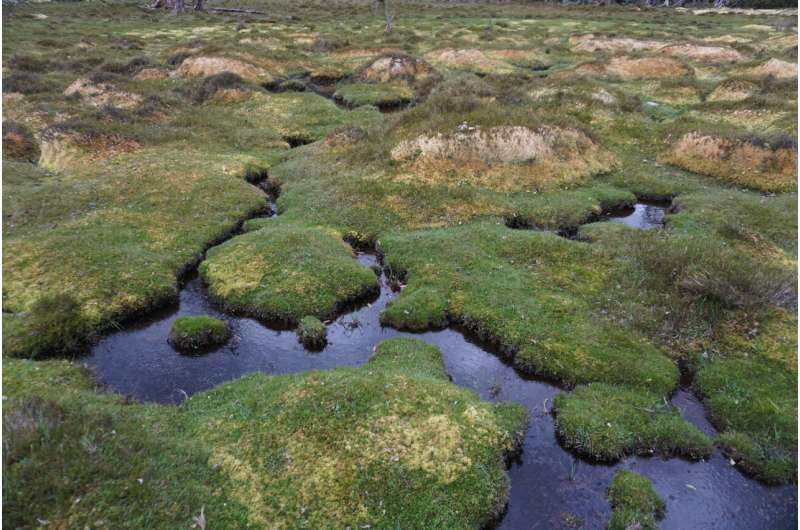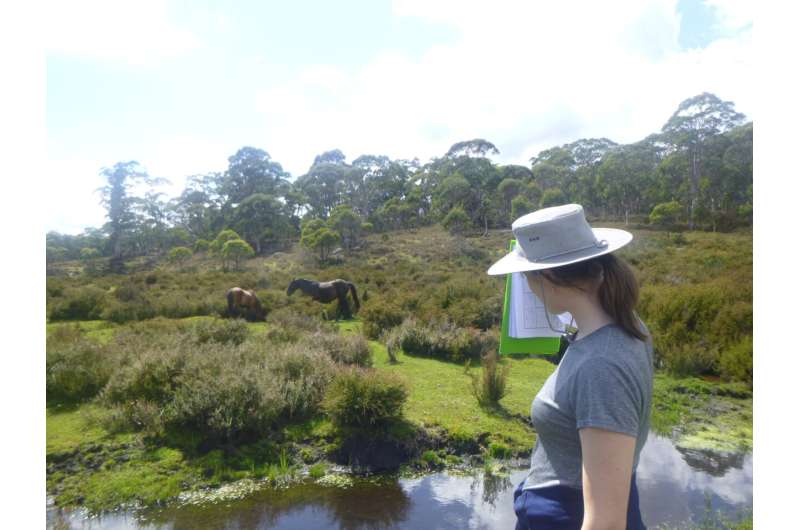This article has been reviewed according to Science X's editorial process and policies. Editors have highlighted the following attributes while ensuring the content's credibility:
fact-checked
peer-reviewed publication
trusted source
proofread
Study suggests link between feral horses and peatland carbon emissions

A new study by RMIT has found carbon emissions from Australian alpine peatlands to be much higher in areas disturbed by feral horses. The paper, "Carbon emissions from Australian Sphagnum peatlands increase with feral horse (Equus caballus) presence," was published in the Journal of Environmental Management .
Peatlands in the Australian Alps are a type of mossy wetland characterized by carbon-rich peat soil, formed from plants that have partially decomposed in wet, swampy conditions. These ecosystems are incredibly effective at capturing carbon in the live moss layer then storing it in the soils below, sometimes for thousands of years.
While peatlands only cover up to 3% of the Earth's land surface, they store an estimated 30% of the world's soil carbon. This is twice the amount of carbon stored in every forest on the planet.
Lead author and postdoctoral researcher, Dr. Sarah Treby, said the protection of these environments is an important step towards addressing global climate change.
"Peatlands are globally significant in capturing and holding carbon. But when they are disturbed, they can release carbon back to the atmosphere as greenhouse gases," Treby said.
"Our new paper on the impact of feral horses in Kosciuszko National Park, New South Wales, is the first to explore how degradation caused by feral horses impacts carbon cycling in Australian alpine and subalpine Sphagnum moss peatlands."
The preliminary study measured peatland carbon dioxide (CO2) emissions using a portable greenhouse gas analyser and transparent chambers, and found they were significantly higher at sites degraded by feral horses compared to sites where horses are not present.
"Previous research has shown feral horses contribute to biodiversity loss and environmental degradation," Treby said.
"Our study shows differences in overall site condition, as well as soil and water quality, between areas with and without feral horses. We found equal evidence of other large feral herbivores between the horse-present/horse-absent sites, so we know that differences in carbon emissions and site condition cannot be attributed to deer or pigs."
"The evidence suggests the damage resulting from horse grazing and trampling could have negative consequences for the long-term carbon storage of affected peatlands."
Feral horses and their effect on carbon cycling
Horses were introduced to Australia in 1788 with the arrival of the first Europeans. Now Australia has approximately 400,000 feral horses,—according to the Invasive Species Council—more than any other country.
More than 18,000 of those are found in Kosciuszko National Park alone, estimates the NSW National Parks and Wildlife Service. Co-author and soil scientist, Dr. Samantha Grover, explained that feral horses are a destructive pest in our uniquely vulnerable Australian ecosystems.
"Horses and other large grazing animals, like sheep and cows, are not native to Australia. Our native wildlife have large, soft feet, and our plants and soils are easily damaged by hard hooves," Grover said.
"Hard-hooved animals damage soils by trampling and compaction, which can lead to erosion, reduced infiltration of water and loss of high-carbon, high-fertility topsoil."

Data collected from sites with and without feral horses showed lowered water and soil quality where feral horses were present.
The research suggests that horses also cause significant loss of soil carbon through waterways, known as fluvial carbon loss. Hard horse hooves trample and erode soils, which can end up in creeks and rivers, instead of in the peatland. This carbon can then be transported downstream and, ultimately, released as carbon dioxide.
Peatlands, in their natural condition, are among the most effective natural carbon capturing and storing ecosystems in the world, far outperforming rainforests. Degraded peatlands, such as those trampled by horses, can instead be carbon sources, releasing more carbon back into the atmosphere than they capture.
Shifting public sentiment
Alpine and subalpine Sphagnum peatlands are endangered in Australia and listed under the Environment Protection and Biodiversity Conservation Act 1999, due to their restricted geographic distribution, biodiversity declines, and challenges in their restoration and regeneration.
Pest population management is routinely carried out in Australia for large hooved animals, including deer, pigs, goats, camels and water buffalo.
Likewise, feral horse population management has been undertaken in many places around the country. However, in some areas—particularly the Australian Alps—control methods that include culling have been controversial and subject to political debate, constraining management programs.
Only recently it was announced that aerial culling will be permitted at Kosciuszko National Park, with the aim to reduce the population size from over 18,000 horses down to 3,000 by 2027. The Kosciuszko National Park Wild Horse Heritage Management Plan cites biodiversity loss and extinction risk for multiple native species as reasons for the cull.
While the study and policy change have both focused on the Kosciuszko National Park, there are Sphagnum moss peatlands—and feral herbivores—across the Australian Alps and Tasmania.
"Our research on these peatlands in the Victorian Alps has shown that, in good condition, they can be strong carbon sinks, removing carbon dioxide from the atmosphere every year," Grover said.
"Australia's alpine peatlands also provide critical habitat and resources for rare and unique species—including iconic alpine frogs, such as the Corroboree and Baw Baw frogs, lizards, small native mammals and invertebrates—as well as water for hydroelectricity, drinking and irrigation.
"While many of Australia's alpine peatlands have been damaged, they have strong potential to recover when protected from hard hooved animals and, ideally, rehydrated.
"Restoring peatlands is both climate smart and nature positive so all Australians benefit when we support our National Parks staff to protect peatlands."
About the research
This research presents the first multi-site comparison of CO2 and methane fluxes from Australian alpine and subalpine Sphagnum moss peatlands, contributing an important initial step towards understanding carbon cycling in these ecosystems.
The study looked at a total of 12 alpine and subalpine Sphagnum moss-dominated bogs (peatlands) in Kosciuszko National Park, which were sampled over a seven-day period in March 2022—seven sites with feral horses present and five without.
The researchers are now seeking to expand the study across the Australian Alps and over a longer time period, to provide a more detailed understanding of the impact of feral herbivores on peatland carbon cycling across Australia.
They are also interested in exploring the restoration of Australian alpine and subalpine peatlands across Australia to help reduce global warming.
More information: Sarah Treby et al, Carbon emissions from Australian Sphagnum peatlands increase with feral horse (Equus caballus) presence, Journal of Environmental Management (2023). DOI: 10.1016/j.jenvman.2023.119034.
Journal information: Journal of Environmental Management
Provided by RMIT University





















